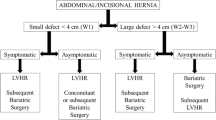Abstract
Background
Laparoscopic ventral hernia repair (LVHR) for morbidly obese patients with a body mass index (BMI) exceeding 35 kg/m2 has not been well investigated.
Methods
Hernia recurrence was evaluated by surveillance computed tomography. A p value less than 0.05 was considered significant.
Results
Between 2003 and 2006, LVHR was attempted for 27 patients with a BMI exceeding 35 kg/m2. There was one conversion to open surgery (3.7%). The 27 patients included 8 men (29.6%) and 19 women (70.4%) with a mean age of 48 years (range, 33–73 years). The mean BMI was 46.9 kg/m2 (range, 35–70 kg/m2). Nine patients (33%) were superobese (BMI > 50 kg/m2), and five patients (22.7%) underwent emergency LVHR because of small bowel obstruction. Concomitant LVHR with laparoscopic gastric bypass (LGB) was performed for 13 patients (48%). Primary, incisional, or recurrent incisional ventral hernia was present in 7 (26%), 15 (55%), and 5 (19%) patients, respectively. A large hernia (>50 cm2) was found in 20 patients (74%). The mesh used was porcine submucosal small intestine extracellular matrix for 15 patients (57%), Gore-Tex for 9 patients (35%), and Composix for 2 patients (8%). The mean hernia size was 158 cm2 (range, 12–806 cm2), and the mean mesh size was 374 cm2 (range, 117–2,400 cm2). The mean operative time was 190 min (range, 80–480 min), and the mean hospital length of stay (LOS) was 3.6 days (range, 1–11 days). Minor or major complications occurred in seven patients (25.9%), and five patients (18.5%) experienced recurrence during a mean follow-up period of 14.9 months (range, 3–32 months). Emergency setting, BMI, concomitant LGB, hernia type, hernia size, and mesh type had no statistically significant effect on operative time, LOS, morbidity, or recurrence rates.
Conclusions
For morbidly obese patients, LVHR is safe and effective, but it is associated with higher likelihood of recurrence, and patients should be appropriately informed.




Similar content being viewed by others
References
Anthony T, Bergen PC, Kim LT, Henderson M, Fahey T, Rege RV, Turnage RH (2000) Factors affecting recurrence following incisional herniorrhaphy. World J Surg 24:95–101
Birgisson G, Park AE, Mastrangelo Jr MJ, Witzke DB, Chu UB (2001) Obesity and laparoscopic repair of ventral hernias. Surg Endosc 15:1419–1422
Bower CE, Reade CC, Kirby LW, Roth JS (2004) Complications of laparoscopic incisional ventral hernia repair: the experience of a single institution. Surg Endosc 18:672–675
Costanza MJ, Heniford BT, Arca MJ, Gagner M (1998) Laparoscopic repair of recurrent ventral hernias. Am Surg 64:1121–1127
Eid GM, Mattar SG, Hamad G, Cottam DR, Lord JL, Watson A, Dallal RM, Schauer PR (2004) Repair of ventral hernias in morbidly obese patients undergoing gastric bypass should not be deferred. Surg Endosc 18:207–210
Henniford BT, Park A, Ramshaw BJ, Voeller G (2003) Laparoscopic of ventral hernias: nine years’ experience of 850 cases. Ann Surg 238:391–400
Leber GE, Garb JL, Alexander AI, Reed WP (1998) Long-term complications associated with prosthetic repair of incisional hernias. Arch Surg 133:378–382
Novitsky YW, Cobb WS, Kercher KW, Mathews BD, Sing RF, Heniford TB (2006) Laparoscopic ventral hernia repair in obese patients. Arch Surg 141:57–61
Raftopoulos I, Vanuno D, Khorsand J, Kouraklis G, Lasky P (2003) Comparison of open and laparoscopic prosthetic repair of large ventral hernias. JSLS 7:227–232
Raftopoulos I, Vanuno D, Khorsand J, Ninos J, Kouraklis G, Lasky P (2002) Outcome of laparoscopic ventral hernia repair in correlation with obesity, type of hernia, and hernia size. J Laparoendosc Adv Surg Tech A 12:425–429
Sugerman HJ, Kellum JM Jr, Reines HD, DeMaria EJ, Newsome HH, Lowry JW (1996) Greater risk of incisional hernia with morbidly obese than steroid dependent patients and low recurrence with prefascial polypropelene mesh. Am J Surg 171:80–84
Author information
Authors and Affiliations
Corresponding author
Additional information
Presented at the 10th World Congress of Endoscopic Surgery Meeting, Berlin, Germany, September 2006
Rights and permissions
About this article
Cite this article
Raftopoulos, I., Courcoulas, A.P. Outcome of laparoscopic ventral hernia repair in morbidly obese patients with a body mass index exceeding 35 kg/m2 . Surg Endosc 21, 2293–2297 (2007). https://doi.org/10.1007/s00464-007-9406-6
Received:
Revised:
Accepted:
Published:
Issue Date:
DOI: https://doi.org/10.1007/s00464-007-9406-6




